Who Invented Biryani? is a question that stirs passion among food lovers, historians, and chefs. The main keyword “Who Invented Biryani” must appear up front because this is the focus of the article. Biryani is more than a recipe. It carries centuries of culture, migration, empire, and local adaptation. In this introduction, you will learn that no one person invented biryani. Instead, it evolved through many influences—Persian, Indian, Arab, and royal kitchens. This article explores who invented biryani, tracing origins, regional forms, and cultural meaning. You will gain deep knowledge while reading in clear, simple English.
Origin Theories
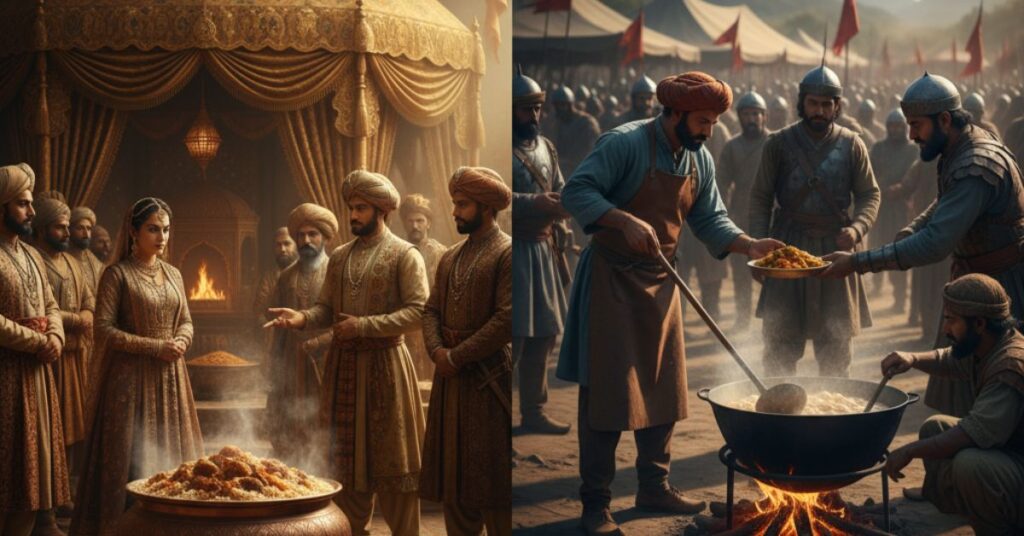
There are several theories about who invented biryani. Some scholars say it came from Persia. Others argue that it grew in India under local cooks who mixed rice and meat long ago. A third view suggests Arab traders brought early forms of rice dishes to South Asia. The truth likely blends all these threads.
It is helpful to see a comparison of theories.
| Theory | Claims | Evidence |
| Persian origin | The word biryani comes from Persian birian (fried) or birinj (rice) | Ancient Persian cookbooks and linguistic studies |
| Indian origin | Indigenous rice‑meat dishes existed before Islamic rule | References in early Indian texts and regional cooking traditions |
| Arab influence | Arab traders brought rice dishes to India | Historical trade route records and recipe similarities |
Pre‑Islamic and Ancient Culinary Influences
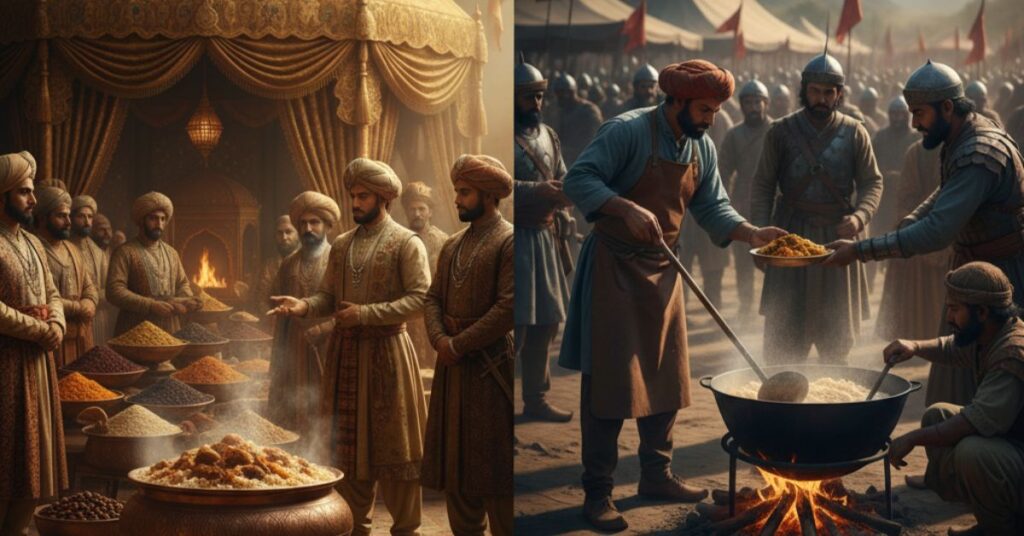
Before Islam and Persian influence, India already had traditions of cooking rice and meat together. Ancient texts like the Mahabharata and Manasollasa refer to rice dishes with spices and meat. These show early South Asian cooks knew how to mix grains and flavors.
At the same time, Middle Eastern cultures had rice dishes. The trade through Silk Road and Indian Ocean routes allowed cooks to share techniques and spices. These contacts brought new ingredients and ideas into Indian kitchens. In that sense, who invented biryani is not just about one land but about exchange over centuries.
You will like this: How Many Calories Are in a Plate of Biryani?
Biryani in Colonial and Modern Times
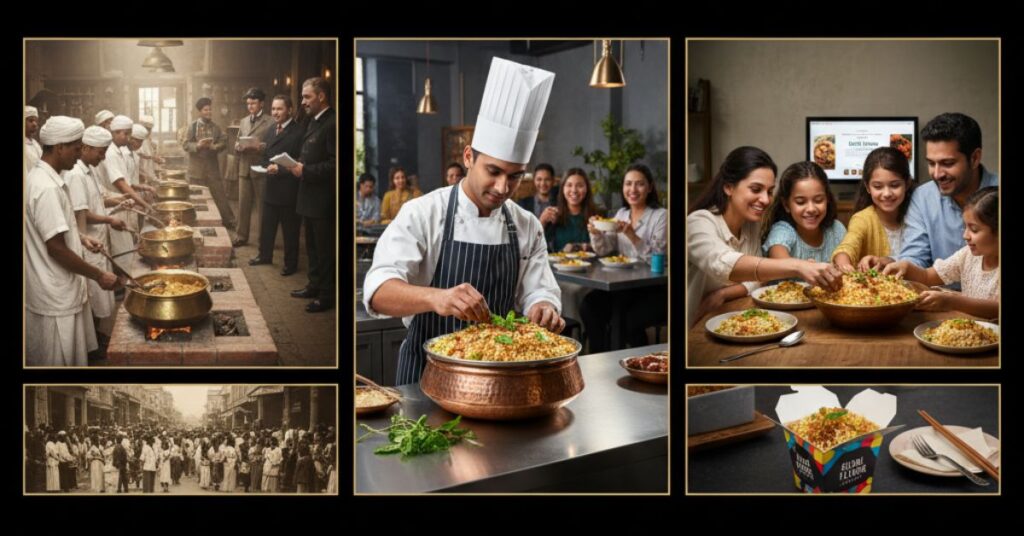
During colonial rule in India, biryani continued to grow in popularity. The British encountered biryani during their time in Bengal, Lucknow, and Hyderabad. They wrote about it in journals and travelogues, amazed at the flavor and preparation. In some places, colonial officers hired Indian cooks just to make biryani for formal dinners.In the 20th century, biryani left the palaces and entered common kitchens. It became a street food, a wedding dish, and even a comfort food.
Migrants from South Asia carried biryani to the Middle East, the UK, the US, and Southeast Asia. Today, biryani is found in Indian restaurants across the world.Whether it’s Beef Biryani in Karachi, Mutton Biryani in Hyderabad, or Chicken Biryani in Kuala Lumpur, every version tells the same story. That biryani is not just food—it’s tradition, memory, and innovation in every bite.
Case Study Hyderabadi vs Kolkata Biryani
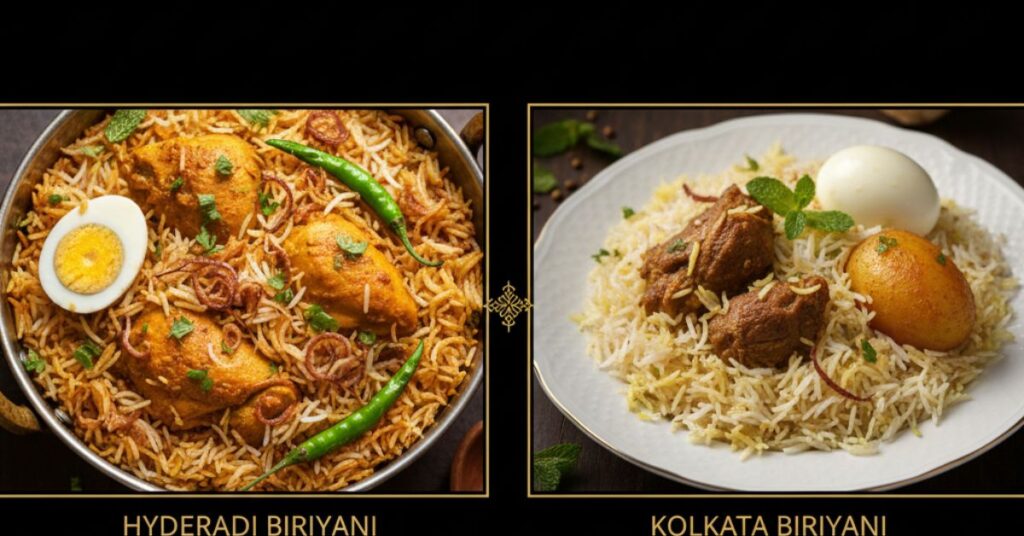
To better understand who invented biryani, let’s compare two famous regional styles that show how much the dish can change while still being called biryani.This comparison shows how two regions, with different resources and histories, made biryani their own. One is fiery and rich. The other is subtle and royal. But both are loved equally. That’s the beauty of biryani—and why no one person or place can truly claim to have invented biryani.
| Feature | Hyderabadi Biryani | Kolkata Biryani |
| Origin | Nizams of Hyderabad (Mughal-Deccan fusion) | Nawab Wajid Ali Shah (exiled from Awadh to Kolkata) |
| Rice | Basmati rice | Basmati rice |
| Protein | Mostly mutton or chicken | Mutton, sometimes chicken |
| Special Ingredient | Fried onions, mint, saffron | Potato (a unique addition), boiled egg |
| Cooking Method | Kachchi (raw meat cooked with rice) and Pakki (cooked meat layered with rice) | Mostly pakki, with meat and rice cooked separately |
| Flavor | Spicy, intense, aromatic | Subtle, fragrant, mildly spiced |
Arrival in the Indian Subcontinent
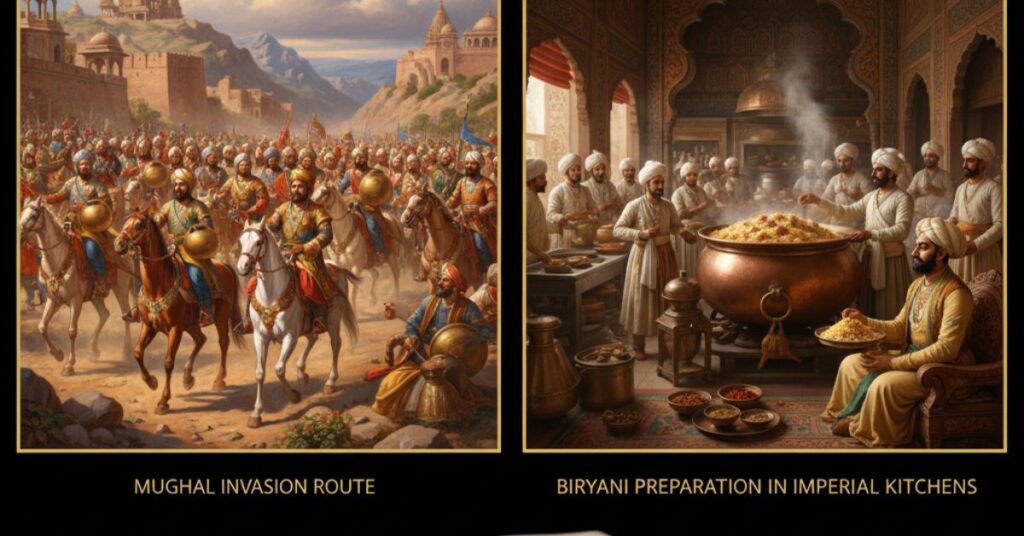
When Islamic rulers and Persian nobles came to India, they brought chefs, ingredients, and culinary techniques. They introduced methods like layering rice and meat and cooking with dum (sealed steaming). These techniques merged with local styles in Indian kitchens. Thus, the idea of biryani as we know it began to take shape in India.
For example, the Mughals brought saffron, dried fruits, and fine rice. They also had royal kitchens that refined many recipes. But local cooks adapted them. Slowly, the fusion of Persian style and Indian flavors created biryani in India. So the question of who invented biryani must include this era of fusion.
Read more: Chicken White Karahi Recipe | Pakistani Creamy Delight
Mughal Royal Kitchens

Within the Mughal courts, biryani grew into a refined dish. Royal chefs, also called rakabdars, invented techniques, seasoning, and presentation. They used layered cooking, marination, and slow steaming. They served biryani at grand banquets and royal ceremonies.
Texts like Ain‑i‑Akbari and traveler accounts record these kitchens and their menus. Emperor Shah Jahan’s court is said to have perfected the dum method. In this royal kitchen, biryani gained prestige. The question of who invented biryani finds one strong candidate here: the chefs in Mughal royal kitchens who formalized the dish.
Regional Variations

As biryani spread across Indian lands, it changed. Local tastes, ingredients, and culture shaped new styles. Each region claimed its version. Here are major ones:Hyderabadi Biryani mixes Mughal style with Deccan spices. It uses saffron, fried onions, and the dum method. Lucknowi (Awadhi) Biryani is delicate and aromatic, using rose water, kewra, and minimal heat.
Kolkata Biryani came when Nawab Wajid Ali Shah was in exile; he added potatoes due to meat scarcity. Malabar (Thalassery) Biryani reflects Arab trade influence; it uses a short-grain rice called kaima. Tamil Muslim Biryani like in Ambur or Dindigul carries regional spice blends and cooking styles.Though each is different, they all answer who invented biryani with a local twist on a shared history.
Cultural Significance

Biryani is more than food. In many parts of South Asia, it is a dish for festivals, weddings, and special occasions. It is linked to status, celebration, and identity. Many families pass secret biryani recipes as heirlooms.
It also has symbolic power. During migrations, people carried biryani recipes to new lands. In the diaspora, biryani became a symbol of home and heritage. In that way, asking who invented biryani is less about a person and more about shared heritage across communities.
Biryani vs. Pulao
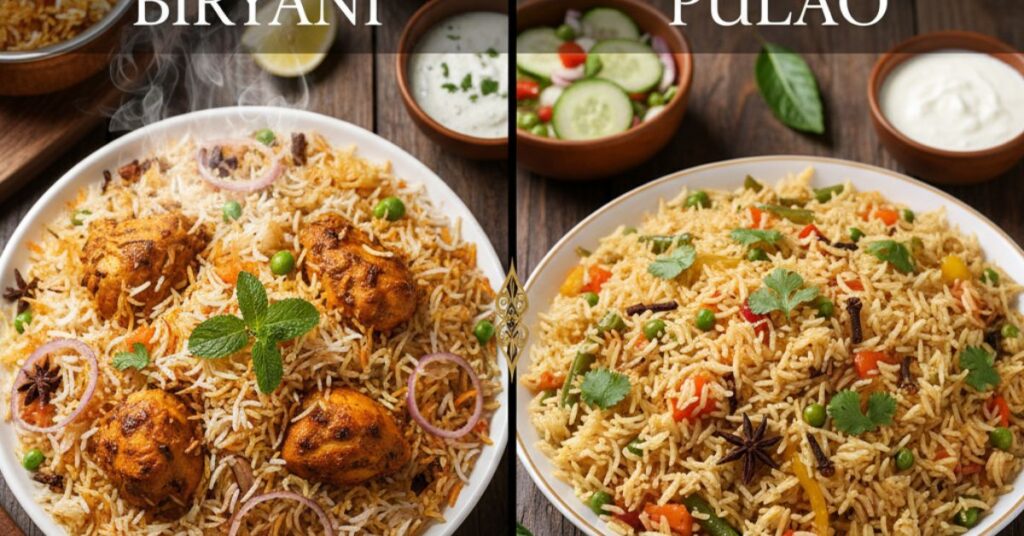
Some confuse biryani with pulao. But they are different. Biryani uses layering, stronger aroma, longer cooking, and more spices. Pulao is cooked in one pot with rice and ingredients together. Biryani’s method brings deeper flavor by steaming in layers.This helps you see why who invented biryani isn’t just about origin but also about technique.
A quick comparison:
| Feature | Biryani | Pulao |
| Cooking method | Layered, sealed, steamed | One‑pot, simpler method |
| Flavor intensity | Bold and layered | Mild and uniform |
| Time | Longer due to marination, steaming | Shorter cooking time |
| Spices | More varied and rich | Fewer spices |
Who Really Invented Biryani?

In truth, no single person invented biryani. The dish is a result of centuries of evolution. It grew from ancient Indian rice dishes, absorbed Persian and Arab techniques, and was refined in Mughal courts. Local regions then made it their own.So when someone asks who invented biryani, you answer: It’s a collective invention. Its creator is history itself. Every region, chef, trader, and cook played a part.
Biryani evolved differently depending on what was available. In some regions, fish or prawns replaced lamb. In others, local herbs were used instead of imported spices. The dish adapted as it traveled, but it never lost its core—a rich, spiced rice dish cooked with protein and love.
Trade Routes and Biryani’s Spread
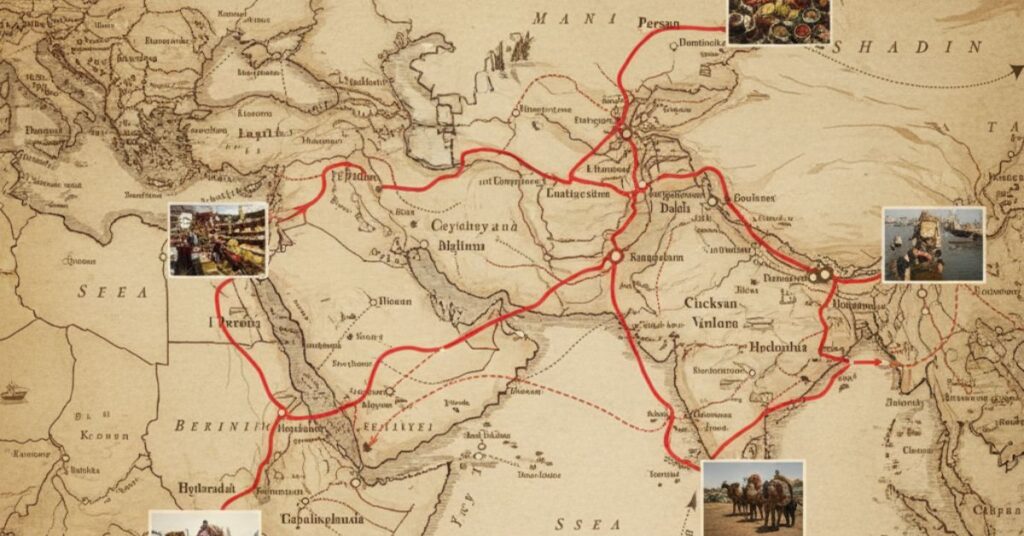
When asking who invented biryani, it’s important to look beyond borders. The dish didn’t stay in one region. Instead, it moved across empires, coastlines, and mountains—thanks to trade. Arab merchants, Persian travelers, and Indian spice traders carried both ingredients and ideas across lands.
The Silk Road helped link Central Asia, Persia, and India. It brought spices, dried fruits, rice varieties, and cooking techniques. Coastal trade along the Arabian Sea and Bay of Bengal also carried food ideas between Arabia, East Africa, and India. South Indian ports like Calicut, Kochi, and Nagapattinam became hubs for exchanging not just spices, but recipes.
FAQ’’S
Who invented biryani?
No one person invented biryani. It evolved from Persian, Indian, and Mughal cooking over many centuries.
Is biryani Indian or Persian?
Biryani has Persian roots but was perfected in India. It’s now a part of Indian heritage.
Is biryani older than pulao?
Pulao is older in records, but biryani is a richer, more developed version influenced by many cultures.
Why does biryani taste different in each region?
Each place uses local spices, rice, and methods, creating unique flavors and styles.
What is the main difference between biryani and pulao?
Biryani is layered and slow-cooked. Pulao is cooked all together in one pot.
Conclusion
Who Invented Biryani? cannot be answered by naming one inventor. The dish emerged through time, culture, and exchange. It started in ancient India, evolved with Persian and Arabic influence, and was polished in Mughal royal kitchens. Regions across India then shaped their own versions. Biryani’s true inventor is history. Your enjoyment of it today is proof of its layered journey.

